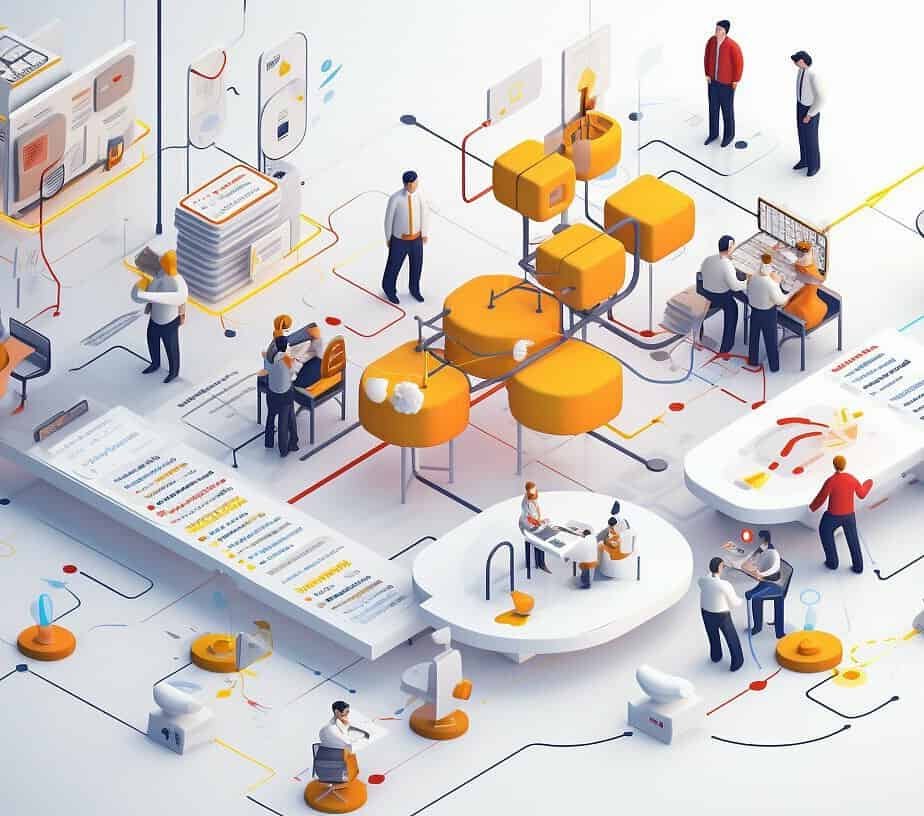Are you tired of struggling with complex data sets and difficult-to-read reports? No need to worry anymore! No code data visualization is here to simplify your analytics journey.
No code data visualization tools are designed to help individuals and businesses create charts, graphs, and other visual representations of data without requiring any coding skills. With these tools, you can easily create visually appealing and easy-to-read reports that can be understood by everyone in your organization.
What is No Code Data Visualization?
No code data visualization refers to creating data visualizations without the need for coding. It allows individuals without technical expertise to create charts and graphs easily. In contrast, traditional data visualization involves coding and often requires specialized knowledge that is difficult for non-technical users to master. No code data visualization aims to bridge this gap by providing easy-to-use tools for creating visualizations quickly and easily.
There are several types of no code data visualization tools available, ranging from web-based dashboards to mobile applications. These tools allow users to upload their data and create various types of charts such as line charts, bar charts, and scatter plots, to name a few.
Advantages of No Code Data Visualization
No code data visualization tools are becoming increasingly popular among individuals and businesses, and for good reason. Here are some of the advantages of using no code tools for data visualization:
- Easy to use: Unlike traditional data visualization tools that require coding expertise, no code tools offer a user-friendly interface that makes creating charts and graphs as easy as drag and drop. This makes it possible for anyone to create visuals that communicate complex data sets, regardless of their technical skills.
- Time-saving: With no code tools, you can create data visualizations in a matter of minutes. This can save you valuable time that would have otherwise been spent writing code or learning complex software.
- Cost-effective: No code tools are often more affordable than traditional data visualization tools, making them accessible to businesses and individuals with limited budgets.
- Flexibility: No code tools offer a wide range of customization options, allowing you to design charts and graphs that fit your specific needs. This includes choosing different chart types, colors, and fonts.
- Collaboration: No code tools make it easy to collaborate with others on data visualization projects, making it possible for multiple people to work on the same project simultaneously.
Overall, using no code data visualization tools can simplify the analytics journey and make data more accessible to everyone, regardless of technical skills. With their ease of use, affordability, and flexibility, no code tools are a great choice for individuals and businesses looking to make sense of complex data sets.
How No Code Data Visualization Works
No code data visualization tools are designed to be user-friendly, allowing users to visualize data sets without requiring coding expertise. These tools operate by providing the user with an interface that enables them to perform data exploration, cleaning, and analysis with ease.
With no code data visualization, users can easily create charts, graphs, and custom visuals by performing simple drag-and-drop functions. Since there is no requirement for any coding, users can instantly visualize the data they have at hand and quickly gain insights into the same.
One key aspect of no code data visualization is that it enables users to explore data sets in different ways. Since users can instantly see the outcomes of different visualizations, they can choose the visualization that works best for their data set and refine it with ease. This allows users to view the data set from different perspectives and surface insights that may have been difficult to discover using traditional data visualization tools.
Benefits of Automated Data Visualization
Visualizing data is an essential aspect of any analysis, and automated data visualization makes it quicker and easier. These tools can quickly create visuals based on data sets, eliminating the need for manual input. This not only saves time but also makes the process less prone to errors.
The speed of data visualization is critical in scenarios where businesses need to make quick decisions based on new data. Automated data visualization tools ensure that the process is quick, reliable and accurate, allowing businesses to make informed decisions in real-time.
Automated data visualization also contributes to improved data quality. Since the process is less time-consuming, analysts can create more visuals after thorough analysis of the dataset, giving them a better understanding of the data. This, in turn, results in more precise data analysis, improving the accuracy of the final results.
Overall, the benefits of automated data visualization are considerable, making it an essential tool for anyone analyzing large quantities of data.
No Code Chart Creation
No code chart creation is one of the key benefits of using no code data visualization tools. With these tools, creating charts and graphs is as easy as drag and drop. Users no longer need to have coding expertise to create charts that are both visually appealing and accurate.
No code chart creation also offers flexibility to the user. With the ability to create different types of charts, users can choose the chart type that best suits their needs. Users can also customize their charts according to their preferences. They can choose the colors, fonts, and data labels that best suit their needs. This flexibility ensures that every chart is unique and optimized to represent the data in the best possible way.
Types of No Code Data Visualization Tools
There are various types of no code data visualization tools available in the market. Here are some of the most popular ones:
| Tool | Description |
|---|---|
| Tableau | Tableau is one of the most widely used no code data visualization tools available in the market. It offers various features such as drag-and-drop functionality and a wide range of chart types to choose from. |
| Google Data Studio | Google Data Studio is a free no code data visualization tool offered by Google. It offers features such as real-time data connection and sharing capabilities. |
| Microsoft Power BI | Microsoft Power BI is another popular no code data visualization tool. It offers advanced visualization features such as AI-powered insights and natural language queries. |
Other notable no code data visualization tools include ChartBlocks, Infogram, and RawGraphs.
How to Choose the Right No Code Data Visualization Tool
Choosing the right no code data visualization tool depends on your specific data visualization needs. Consider factors such as the level of complexity of your data, the number of users who need to access the tool, and the level of customization you require. It’s also worth considering the level of customer support offered by the tool’s provider, as this can be a key differentiator between two similar products.
Popular No Code Data Visualization Tools
There are numerous no code data visualization tools available, each with its own set of features and capabilities. Here is an overview of some of the most popular tools:
| Tool Name | Features | Pros | Cons |
|---|---|---|---|
| Tableau | Dashboard building, data blending, and real-time collaboration | User-friendly, excellent visualization options, good integration capabilities | Expensive, requires basic technical knowledge to fully utilize |
| Google Data Studio | Customizable data visualizations, real-time data, collaboration, and sharing | User-friendly, free to use, easily integrates with Google products | Limited visualization options, requires some technical knowledge |
| Power BI | Real-time and interactive dashboards, data modeling, and AI-driven insights | User-friendly, good integration with Microsoft products, affordable | Less customization options than other tools, requires basic technical knowledge |
| Zoho Analytics | Customizable dashboards, data blending, AI-based analytics, and collaboration options | User-friendly, affordable, good for small and medium-sized businesses | Limited visualization options, reports can be slow to load with large datasets |
All of these tools offer no code functionality, making them accessible to users without coding experience. Each tool also has its strengths and weaknesses, so it’s important to carefully evaluate your specific needs before selecting a tool.
Comparing Popular Tools
Tableau, Google Data Studio, Power BI, and Zoho Analytics are four of the most popular no code data visualization tools available. While each tool is powerful in its own way, it’s essential to compare them to ensure you select the best tool for your needs.
Tableau is a top-tier tool that offers a range of features, making it an excellent choice for large organizations. Data Studio, on the other hand, is ideal for small to medium-sized businesses, thanks to its affordability and user-friendly interface. Power BI is a Microsoft product, which means it integrates well with other Microsoft tools, making it a popular choice for those already invested in the Microsoft ecosystem. Zoho Analytics is another affordable option, suitable for smaller businesses with less complex data visualization needs.
Ultimately, the tool you choose will depend on factors such as your budget, data visualization requirements, level of technical expertise, and data sources.
Best Practices in No Code Data Visualization
No code data visualization tools can help users create eye-catching and informative charts and graphs without requiring any coding expertise. Here are some best practices to follow when using these tools:
- Pick the right tool: There are various no code data visualization tools available, and it’s essential to pick the right one based on your needs. Consider factors such as the type of data you have and the type of visualization you want to create.
- Choose the right chart types: Different charts and graphs are suitable for different types of data. Make sure to choose the right chart type that will effectively communicate your data insights to your audience.
- Prepare your data: To create effective visualizations, your data needs to be clean, organized, and in the right format. Spend some time preparing your data before you start creating visualizations.
- Keep it simple: While it may be tempting to create a complex visualization, it’s better to keep it simple. Avoid cluttering your charts and graphs with too much information that may distract the reader from the key insights.
- Use color effectively: Color can be used to highlight important information, and it’s essential to use it effectively. Make sure to choose colors that are easy to read and complement each other.
By following these best practices, you can create engaging and impactful visualizations that effectively communicate your data insights to your audience.
No Code Data Visualization for Business
No code data visualization tools are extremely useful for businesses to visualize complex data in a user-friendly manner. With the help of these tools, businesses can easily analyze trends, make data-driven decisions, and improve their overall performance. Let’s dive deeper into how businesses can benefit from using no code data visualization tools.
Why is Data Visualization Important for Businesses?
Businesses collect an enormous amount of data on a daily basis. However, it can be tricky to navigate and make sense of all the data without the help of data visualization tools. By visualizing this data in the form of graphs, charts, and tables, businesses can easily identify patterns, trends, and insights that they might have otherwise missed. This, in turn, can help them make data-driven decisions, improve their performance, and stay ahead of the curve.
How Can No Code Data Visualization Tools Help Businesses?
No code data visualization tools are designed to be user-friendly and accessible to individuals who do not have a coding background. This means that businesses can easily use these tools without having to rely on technical expertise. Additionally, these tools are typically quicker and more cost-effective than traditional data visualization tools, making them an ideal choice for businesses of all sizes.
No code data visualization tools also allow businesses to create interactive visualizations that can be easily shared and collaborated on. This means that stakeholders can work together on the analysis of complex data sets, leading to more accurate and insightful decisions.
How to Choose the Right No Code Data Visualization Tool for Your Business
When it comes to choosing the right no code data visualization tool for your business, it’s important to consider your specific needs and requirements. Some popular options include Tableau, Google Data Studio, and Microsoft Power BI. Each of these tools has its own unique features and benefits, so it’s important to do your research to determine which one is the best fit for your business.
Additionally, it’s important to remember that while no code data visualization tools can be incredibly useful, they are not a one-size-fits-all solution. As with any technology, there are limitations to what these tools can do. Therefore, it’s important to have a strong understanding of your data and the insights you hope to gain from it before diving into any data visualization project.
Future of No Code Data Visualization
No code data visualization is set to change the way businesses and individuals approach data analysis. As we look into the future of no code data visualization, it is clear that there will be even more advancements that will make data visualization even more accessible and streamlined.
The Rise of AI & Machine Learning in Data Visualization
With the rise of AI and machine learning, no code data visualization tools will be able to identify patterns in data and suggest the best way to visualize it. This will not only save time but also make it easier for users to find insights that they may have missed.
| Pros | Cons |
|---|---|
| Automation of the data analysis process | Inability to capture complex patterns and insights |
| Improved accuracy and precision of data analysis | Risk of over-reliance on AI and machine learning |
Increased Integration and Customization
No code data visualization tools will continue to integrate with other software and platforms, making it easier to access and analyze data from different sources. Moreover, users will have more control over the design and customization of their data visualizations, enabling them to create unique and impactful visuals.
Expansion to New Industries
As the benefits of no code data visualization become more widely recognized, the use of these tools will expand to new industries. From healthcare to education and beyond, businesses and individuals in a variety of fields will be able to leverage the power of no code data visualization to improve their understanding of complex data sets and make informed decisions.
- Predictive analytics will play a bigger role in data visualization.
- Cloud-based solutions will become more widely available.
Overall, the future of no code data visualization is bright. Advancements in technology and increased integration will make data visualization more accessible and user-friendly than ever before.
FAQ’s on No Code Data Visualization
As no code data visualization is a relatively new concept, it’s natural to have a few questions. We’ve compiled some of the most common ones to help you out.
What is the difference between traditional data visualization tools and no code data visualization tools?
Traditional data visualization tools require coding expertise, whereas no code data visualization tools do not. No code tools operate with drag and drop features, making them easy to use for beginners and experts alike.
What are the advantages of using no code data visualization?
No code data visualization tools offer many advantages. They are user-friendly, quick, and efficient. They enable users to analyze and present complex information in an easy-to-understand way. These tools can save valuable time for individuals and businesses who want to visualize data sets without coding.
Which industries can benefit from no code data visualization?
No code data visualization can benefit almost all industries including business, finance, healthcare, and education. These tools can help businesses to make informed decisions based on data insights, spot trends, and opportunities that they might have otherwise missed.
Which is the best no code data visualization tool for me?
There are many no code data visualization tools available, each with their own unique features. It depends on your specific needs. Some popular tools include Tableau, Google Data Studio, and Infogram. It’s important to research and compare different tools before choosing the one that works best for you.
What are some best practices for using no code data visualization tools?
Some best practices for using no code data visualization tools include selecting the right tool for your specific needs, choosing the appropriate chart types, and preparing your data properly. These tips can help you create effective and visually appealing data visualizations.




0 Comments